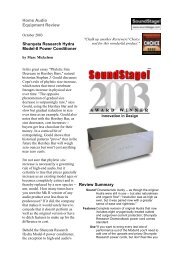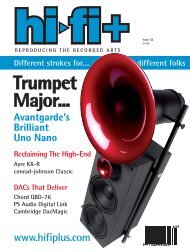the art audio carissa 845 set amplifier - Audio Note Singapore
the art audio carissa 845 set amplifier - Audio Note Singapore
the art audio carissa 845 set amplifier - Audio Note Singapore
Create successful ePaper yourself
Turn your PDF publications into a flip-book with our unique Google optimized e-Paper software.
THE ART AUDIO CARISSA <strong>845</strong> SET AMPLIFIER<br />
Art <strong>Audio</strong>'s new Carissa is a 16wpc, <strong>845</strong>-based, no negative feedback, single-ended<br />
triode <strong>amplifier</strong> that operates in pure Class A. Retailing at $3,995 with black chassis<br />
and chrome accents - or $4,495 with hand-polished stainless steel case - it is nei<strong>the</strong>r<br />
cheap nor bank-breaking. Fur<strong>the</strong>r specs include input sensitivity of 600mV; input impedance<br />
of 180kohms; output impedance of 1.2 ohms; and frequency response of<br />
20Hz-20kHz +/-1dB to full rated power. The Carissa's binding posts can be internally<br />
connected to <strong>the</strong> output transformers' 8- or 4-ohm taps. My sample was connected at 8<br />
ohms. A 3-year warranty covers p<strong>art</strong>s & labor, an optional passive volume control is<br />
available for $200. Standard power tubes are by Valve Art, but KR <strong>Audio</strong> equivalents<br />
may be substituted for an additional $500 - <strong>the</strong>se upgrade tubes retail separately for<br />
$600.<br />
My sample didn't come with <strong>the</strong> optional $500 active-convection glass chimneys and polished stainless collars<br />
[upper right] but did have a working heat sink - visible below at <strong>the</strong> rear of <strong>the</strong> amp - which is connected to <strong>the</strong> input<br />
transformer. Originally, this heat sink was implemented on all of Art <strong>Audio</strong>'s higher-voltage models but isn't strictly<br />
necessary for lower-power domestic models built for 117V/60Hz line voltages. Never<strong>the</strong>less, it is available for $25 -<br />
about Art <strong>Audio</strong>'s cost.<br />
The Carissa measures 12½ inches wide by 19 inches deep by 10½ inches high when measured at <strong>the</strong> top of <strong>the</strong><br />
output tubes. It weighs around 60 pounds and represents a real hunk of <strong>amplifier</strong>. In its polished stainless livery, it<br />
represents a beautiful hunk too, one that strikes me as a no-brainer even at its premium price. Construction and<br />
finish quality are robust and superb. Hardware used is first rate, two pairs of sturdy gold-plated brass 5-way binding<br />
posts - just one pair per channel - and two gold-plated, chassis-mounted RCAs. Of course <strong>the</strong> IEC power inlet is<br />
standard fare <strong>the</strong>se days and invites experimentation with after-market power cords. Lastly, at <strong>the</strong> right rear of <strong>the</strong><br />
amp is <strong>the</strong> power switch. There are no provisions for biasing - <strong>the</strong> amp is completely self-biased.<br />
In his sneak peek, Srajan wrote "Considering its size, heft, power and detail<br />
work versus <strong>the</strong> o<strong>the</strong>r entrants of <strong>the</strong> line, <strong>the</strong> Carissa nearly screams loss<br />
leader." And it's true - it screams that loud and clear, something Art <strong>Audio</strong>'s<br />
Joe Fratus verified as fact. Fratus told me that <strong>the</strong> Carissa has been introduced<br />
at a price that reduces <strong>the</strong>ir normal profit margin, in order to bring it<br />
within reach of those not previously able to consider this marquee. My advice<br />
is to not underestimate this <strong>amplifier</strong> based on its retail price positioning. This<br />
is nobody's entry-level amp.<br />
What, a watt is a watt? Not!<br />
Automotive enthusiasts know how <strong>the</strong>re's more to engine performance than can be gleaned from its noted horsepower.<br />
Horsepower only tells so much of <strong>the</strong> story. There's also low-end torque to consider, and its ability to get a<br />
car off <strong>the</strong> mark. Then <strong>the</strong>re's midrange performance, determined by <strong>the</strong> engine's power band which in turn is determined<br />
by where <strong>the</strong> torque peaks and falls off proportionally to where horsepower takes <strong>the</strong> baton and (hopefully)<br />
surges to redline.<br />
But <strong>the</strong>re's even more to a car's performance than can be ga<strong>the</strong>red from <strong>the</strong> above. After all, <strong>the</strong> engine doesn't<br />
perform in a vacuum, isn't directly connected to <strong>the</strong> wheels but intermediated by a transmission. The transmission's<br />
gear ratios will determine how engine torque is best utilized. It's why a little four-banger can get off <strong>the</strong> mark almost<br />
as quickly as a much larger engine. After reaching cruising speed, <strong>the</strong> smaller power plant might even be able to<br />
keep up with its larger counterp<strong>art</strong> - as long as <strong>the</strong> terrain is flat. But a steep incline will have <strong>the</strong> little engine fall<br />
behind unless <strong>the</strong> driver gears way down. It just doesn't have <strong>the</strong> horsepower to keep up with <strong>the</strong> bigger motor.
Amplifiers are a lot like engines. They are <strong>the</strong> driving force in <strong>audio</strong> and mostly<br />
judged by <strong>the</strong>ir horsepower delivery (watts) but with little concern expended<br />
over torque (current). Nei<strong>the</strong>r do <strong>the</strong>y operate in a vacuum. They require careful<br />
matching to a transmission (speakers) before <strong>the</strong>re is music. You wouldn't pair<br />
a low-powered <strong>amplifier</strong> with a speaker that only came to life at high revs. Surprisingly,<br />
pairing a big amp with a high-efficiency speaker not requiring those<br />
high revs is no guarantee for performance ei<strong>the</strong>r - unless it delivered high<br />
torque at low RPMs. A high-efficiency speaker may be far better off paired with<br />
a very small <strong>amplifier</strong> that maximizes its power delivery band within, not outside<br />
<strong>the</strong> speaker's usable range. In this case, current is at least as important as<br />
watts. Which brings me to <strong>the</strong> Art <strong>Audio</strong> Carissa, just one such <strong>amplifier</strong>. Judge<br />
its fortitude and brawn based on its relatively meager specs at your own peril.<br />
As <strong>the</strong>y say, "it's not <strong>the</strong> size of <strong>the</strong> sword but <strong>the</strong> fury of its onslaught"<br />
[especially when <strong>the</strong> puny pen is said to be mightier - Ed.].<br />
Where <strong>the</strong> rubber meets <strong>the</strong> road<br />
When I read in Srajan's preview that I was expected to try <strong>the</strong> Carissa on my pair of Magnapan MG 1.6QRs, I<br />
thought he'd probably been out too long in <strong>the</strong> New Mexican sun. Everybody knows that <strong>the</strong> 1.6QRs require a big<br />
solid-state <strong>amplifier</strong>. Right? Well, not necessarily - but still, what affront to common sense.<br />
Long story short, once I installed <strong>the</strong> higher-current KR <strong>Audio</strong> <strong>845</strong> tubes, I<br />
was shocked at how well <strong>the</strong> Carissa handled <strong>the</strong> Maggies. Sure, 16 watts of<br />
revving power limited ultimate loudness but <strong>the</strong> amp had <strong>the</strong> unexpected current<br />
delivery and torque to take <strong>the</strong> Maggies firmly in hand. Bass was surprisingly<br />
robust -- solid and tuneful -- and where <strong>the</strong> stock Valve Art tubes produced<br />
an upper midrange a bit too laid-back, <strong>the</strong> KRs snapped <strong>the</strong> Maggies<br />
back in line to sound splendidly neutral.<br />
Naturally, nobody in <strong>the</strong>ir right mind is going to recommend <strong>the</strong> long-term<br />
mating of <strong>the</strong> Art <strong>Audio</strong> Carissa and <strong>the</strong> Maggies. I won't ei<strong>the</strong>r. But <strong>the</strong> exercise<br />
-- as apparently intended -- aptly demonstrated that this is not your<br />
stereotypical prissy SET <strong>amplifier</strong>. It was but <strong>the</strong> first glimpse of what is so<br />
special about this plucky <strong>amplifier</strong>.<br />
Art <strong>Audio</strong> claims that <strong>the</strong> Carissa is "a different twist on o<strong>the</strong>r <strong>845</strong> based <strong>amplifier</strong>s. Of course, <strong>the</strong> hand-wound<br />
split-core output transformers - not usually seen in SET designs - and power supply (designed by Art <strong>Audio</strong>'s<br />
UK founder Tom Willis) are <strong>the</strong> secret ingredients." I'm told that a rethinking of what has been standard procedure in<br />
<strong>845</strong> <strong>amplifier</strong> design netted some noteworthy innovations. First, Art <strong>Audio</strong> lowered <strong>the</strong> input impedance at <strong>the</strong> output<br />
transformer to boost dynamics, clarity, and high frequency extension. Next, <strong>the</strong>y eschewed tubed voltage regulation<br />
in favor of Mosfets. Last but not least, <strong>the</strong>y significantly lowered plate voltage to 800 volts, doubling available<br />
current over traditional designs at <strong>the</strong> expense of fewer available output watts. Then <strong>the</strong>re was <strong>the</strong> choice of <strong>845</strong><br />
power triodes.<br />
The optional KR <strong>Audio</strong> <strong>845</strong>, said to be one of Dr. Riccardo Kron's last designs before his recent death, is, among<br />
o<strong>the</strong>r things, responsible for some difficulty organizing this review. I could easily have written an entirely separate<br />
review on <strong>the</strong> Carissa with <strong>the</strong> KR <strong>845</strong> installed - <strong>the</strong> difference between <strong>the</strong> Valve Art and KR tubes is that significant.<br />
But in <strong>the</strong> end, what makes <strong>the</strong> KR tube significant is that it shares <strong>the</strong> basic <strong>the</strong>me of <strong>the</strong> Carissa while taking<br />
it to ano<strong>the</strong>r level. Though <strong>the</strong> Carissa with <strong>the</strong> Valve Art tubes installed sounds very different from <strong>the</strong> Carissa with<br />
<strong>the</strong> KR tubes, both share <strong>the</strong> same traits, just to different degrees. Everything about <strong>the</strong> Carissa is intensified<br />
through <strong>the</strong> use of <strong>the</strong> KR tube. If you like what <strong>the</strong> Valve Art-equipped Carissa is all about, you may be ecstatic<br />
about what <strong>the</strong> KR does. Or, you may not. The intensified bass of <strong>the</strong> KR could be too much for your room or your<br />
tastes. I can't imagine why, but you may not enjoy <strong>the</strong> added saturation of tonal colors and harmonics that <strong>the</strong> KR<br />
brings to <strong>the</strong> table, nor its added drive. But you do owe yourself an audition of <strong>the</strong> Carissa equipped both ways.<br />
For <strong>the</strong> duration of <strong>the</strong> review, be mindful that I'm talking about <strong>the</strong> Carissa with <strong>the</strong> stock Art Valve tubes - but feel<br />
free to read between <strong>the</strong> lines, to infer that all positive observations were intensified with <strong>the</strong> insertion of <strong>the</strong> KR<br />
<strong>845</strong>. I st<strong>art</strong>ed off by talking about fortitude - completely unexpected in an <strong>845</strong> <strong>amplifier</strong>. But that's only <strong>the</strong> beginning<br />
of <strong>the</strong> Carissa's charms. This is one seriously charismatic <strong>amplifier</strong>, with all <strong>the</strong> fine attributes that tubes have to<br />
offer. Those who favor <strong>the</strong> <strong>845</strong> beam triode will instantly find much to love. Those not familiar will be instantly impressed<br />
by an expansive, light and airy soundstage. Loyalists won't be bo<strong>the</strong>red at all by slightly soft image outlines<br />
- as compared to what 300B or even EL-34 fans may expect - though <strong>the</strong>y still exceed what live music offers. While<br />
depth is very good, <strong>the</strong> Carissa isn't exactly <strong>the</strong> last word in front-to-back layering.
A soft and romantic treble is ano<strong>the</strong>r common expectation. Here <strong>the</strong> Carissa comes closer to conforming to expectations<br />
-- if only to a degree -- but still surprises. Like a Champagne Sabayon, <strong>the</strong> Carissa produces a treble that is<br />
crisp yet sweet and gentle, with a velvety smoothness that never bites. Not dark or closed-in, it's never<strong>the</strong>less not<br />
quite <strong>the</strong> ultimate statement in hyper extension. But, it's eminently satisfying and always forgivingly musical.<br />
Through <strong>the</strong> midrange, <strong>the</strong> Art <strong>Audio</strong> Carissa has all <strong>the</strong> transparency and intimacy<br />
aficionados will expect of just about any SET <strong>amplifier</strong>, in this price range<br />
and beyond. It doesn't quite measure up to <strong>the</strong> standards <strong>set</strong> by some 300B<br />
<strong>amplifier</strong>s but far surpasses any EL34 or 6550 tube I've ever heard - and it<br />
comes with a combination of price and raw moxy that seems almost too good<br />
to be true. From what I ga<strong>the</strong>r, an important priority at Art <strong>Audio</strong> is an amp's<br />
ability to drive real world speakers. I reckon that from reading <strong>the</strong>ir website, but<br />
mostly from living with <strong>the</strong> Carissa. This 16-watt <strong>amplifier</strong> drives like no o<strong>the</strong>r<br />
tube <strong>amplifier</strong> I've heard. Through <strong>the</strong> bass region, it reminds me of <strong>the</strong> push/<br />
pull <strong>Audio</strong> Research VS-55, a 50wpc <strong>amplifier</strong> utilizing <strong>the</strong> 6550 tube, well<br />
known for its bass prowess though less so for musical finesse and transparency.<br />
Not only does <strong>the</strong> Carissa do bass like <strong>the</strong> ARC but it sounds every bit<br />
as powerful. I never ran short of power. This shiny <strong>amplifier</strong> maintained a previously<br />
unheard-of control over my Silverline Sonata IIs’ twin woofers - and<br />
through some very spirited listening sessions to boot.<br />
The Carissa has, at least temporarily, changed my listening habits. It's got me pulling out Rock recordings<br />
that I ei<strong>the</strong>r haven't listened to in a while, or that were sonically too disappointing to use as<br />
p<strong>art</strong> of <strong>the</strong> review process. Two such CDs suffer from a multitude of careless mastering sins: Bowling<br />
For Soup's Drunk Enough To Dance [Silverstone/Jive 01241-41819-2] and Avril Lavigne's Let<br />
Go [Arista 07822-14740-2]. Both exhibit no more than <strong>the</strong> usual amount of Pop CD midrange veiling<br />
- but <strong>the</strong> tremendously transparent Carissa does a superb job of minimizing that annoyance. The<br />
<strong>amplifier</strong> fur<strong>the</strong>r produces a meaty and harmonically dense presentation that lends superb body to<br />
both CDs to help propel <strong>the</strong> music. Not only do vocals project as <strong>the</strong>y never did before, but <strong>the</strong>y<br />
emerge from a huge wall of highly saturated sound that perfectly serves <strong>the</strong> music.<br />
Of course <strong>the</strong>se CDs are also well served by <strong>the</strong> Carissa's aforementioned bass prowess, so much<br />
so that I've enjoyed listening to this <strong>amplifier</strong> with hard-driving Rock more than any <strong>amplifier</strong> I've ever<br />
had here, my Herron M150s excepted - possibly. Remember all that talk about car engines and<br />
amp/speaker matching? The Carissa, by leaps and bounds, sounds more powerful into my Silverlines<br />
than my 500-watt Bryston 7B STs. It's not even close. The Brystons sound hollow and anemic<br />
by comparison. But before I give <strong>the</strong> impression that <strong>the</strong> Carissa is a bass-heavy monster superimposing<br />
its personality on every CD and system it comes in contact with, let me <strong>set</strong> that record<br />
straight.<br />
One day I gave a spin to a Telarc copy of Hector Berlioz' Symphonie Fantastique, Op.14 [Telarc CD<br />
80076] and sat back for some bombastic fun. I expected <strong>the</strong> Carissa's usual way and looked forward<br />
to some plucked double basses energizing my room as maybe I'd never heard <strong>the</strong>m do before, even<br />
if sounding a bit larger than life in turn. Didn't happen. It wasn't until <strong>the</strong> 5th movement when <strong>the</strong><br />
fireworks commence [think of <strong>the</strong> repetitive segment throughout Julia Roberts' Sleeping With The<br />
Enemy if you don't know it] that <strong>the</strong> Carissa even st<strong>art</strong>ed to show its metal. It was basically <strong>the</strong> same<br />
when I fired up Rostropovich, Return To Russia [Sony Classical SK 45836]. I st<strong>art</strong>ed to realize that<br />
<strong>the</strong> Carissa doesn't add bass; it just makes <strong>the</strong> absolute most of whatever it finds. If <strong>the</strong> CD contains<br />
gentle shadings, that's what <strong>the</strong> Carissa delivers. But when <strong>the</strong> bass gets loud, powerful and demanding<br />
of <strong>amplifier</strong> current, <strong>the</strong> Carissa, more so than any tube <strong>amplifier</strong> I've ever used, steps up to<br />
give you what you paid for.<br />
Through <strong>the</strong> midrange, or more specifically, through <strong>the</strong> upper midrange, <strong>the</strong> Carissa isn't exactly<br />
<strong>the</strong> last word in neutrality. Like a good Sauvignon Blanc, it has a crispness that is stimulating, refreshing<br />
and bold, making it <strong>the</strong> perfect complement to <strong>the</strong> Carissa's overall forthright and full-bodied<br />
character. It features a gentle upward-tilt through <strong>the</strong> upper mids that adds life, excitement and<br />
charged musical emotion. This deviation from linearity is minor in amplitude and no greater than<br />
found with highly regarded <strong>amplifier</strong>s of varying persuasions. While this aberration isn't nearly large<br />
enough to be characterized as bright, it does result in some added vibrancy to strings, brass, guitar<br />
and female vocals. It also brings <strong>the</strong> soundstage just a touch closer. In my room, <strong>the</strong> music just<br />
comes alive. The infusion of energy through this region can be absolutely addicting. It not only increases<br />
tonal saturation, it balances <strong>the</strong> bass for a really kinetic rush. Instruments through this range<br />
are more expressive and emotionally communicative and never detrimental to musical cohesion.
Every Breath You Take: The Classics, <strong>the</strong> Police compilation SACD [A&M06949 36072], made for an<br />
interesting experience. The first three tracks don't indicate much in <strong>the</strong> way of remastering and are<br />
sonic disappointments. Still, <strong>the</strong> transparency of <strong>the</strong> Carissa well illuminates <strong>the</strong> changes in recording<br />
techniques and venues used from track to track, imposing no personality in <strong>the</strong> process - <strong>the</strong><br />
first three cuts indeed have very little in common. But by <strong>the</strong> time "Walking On The Moon" cues up,<br />
things change radically. There's that bass authority and power I was talking about earlier. Sting's<br />
bass line is as intense as Stu<strong>art</strong> Copeland's drum beat. And it's tight, resonant and <strong>art</strong>iculate, with<br />
lots of air around instruments in a very expansive sense of space, Sting's voice incredibly present.<br />
David Johansen And The Harry Smith's SACD [Chesky SACD 225] is an album that held few if any<br />
surprises since <strong>the</strong> Carissa wasn't called upon to create anything supernatural. But boy did it sound<br />
good. It's a very well recorded SACD (sounding good in multichannel as well) with transparency in<br />
spades. Not only did <strong>the</strong> Carissa get me up close and personal with Johansen's vocals, <strong>the</strong> bass<br />
lines, while not unduly heavy, just oozed au<strong>the</strong>nticity with rich woody resonance and all <strong>the</strong> attendant<br />
string/neck buzz. The bluesy riffs from <strong>the</strong> acoustic guitar hung in <strong>the</strong> air like cigarette smoke in a<br />
bar.<br />
While I was going though my lesser listened-to SACDs, I came upon Stevie Ray Vaughn's Couldn't<br />
Stand The Wea<strong>the</strong>r [Epic/Legacy ES 65871]. I'm a huge SRV fan. In my book, he's one of <strong>the</strong> best<br />
<strong>the</strong>re ever was. But his is not <strong>the</strong> kind of music that you sit, eyes closed, in front of <strong>the</strong> speakers with.<br />
Half <strong>the</strong> time, I have to pick up my own guitar to play along, only to put it down in frustration five minutes<br />
later - but that's ano<strong>the</strong>r story. Imagine my surprise when I sat at <strong>the</strong> conclusion of "Stang's<br />
Swang" to suddenly hear Stevie talking! It was <strong>the</strong>n that I learned of five bonus tracks I'd never noticed<br />
before. In more than a year of owning <strong>the</strong> disc, I'd never sat still long enough to hear it all <strong>the</strong><br />
way through. On this day, I apparently couldn't get enough. That's <strong>the</strong> extent of <strong>the</strong> Carissa's mesmerizing<br />
power.<br />
Point/Counterpoint<br />
At <strong>the</strong> conclusion of <strong>the</strong> <strong>Audio</strong>pax Stereo 88 review, I promised to compare<br />
<strong>the</strong> two amps in today's evaluation. Drawing distinctions between <strong>the</strong>se two<br />
very excellent performers is easy to do. Choosing which one to take home?<br />
That'd be a whole 'nu<strong>the</strong>r matter.<br />
Both <strong>amplifier</strong>s are superbly transparent. The slight up-tilt in <strong>the</strong> Carissa's<br />
upper mids causes differentiation from <strong>the</strong> Stereo 88 in several ways. First,<br />
<strong>the</strong> Carissa's soundstage presentation is more up- front and intimate while<br />
<strong>the</strong> <strong>Audio</strong>pax moves it significantly behind my speakers. The <strong>Audio</strong>pax also<br />
throws more highly delineated images with more obvious degrees of depth,<br />
though both go nice and deep. Soundstage focus too is a touch better with<br />
<strong>the</strong> Brazilian. Perhaps it's <strong>the</strong> frequency response contouring, perhaps not -<br />
but <strong>the</strong> Carissa sounds just slightly more raw and raucous through <strong>the</strong> upper<br />
vocal range where <strong>the</strong> <strong>Audio</strong>pax merely exudes smooth refinement. Ano<strong>the</strong>r<br />
listener may describe <strong>the</strong> Carissa as <strong>the</strong> more aggressive of <strong>the</strong> two, <strong>the</strong><br />
Stereo 88 <strong>the</strong> more polite. Depending on <strong>the</strong> music being played, <strong>the</strong> scales<br />
could tip ei<strong>the</strong>r way for me.<br />
I don't detect a whole lot of difference between <strong>the</strong> treble performance in<br />
ei<strong>the</strong>r amp. Both are first rate and I'd take <strong>the</strong>ir music-friendly nature and run<br />
with it any day of <strong>the</strong> week. Down low is where <strong>the</strong> two completely diverge. I<br />
characterized <strong>the</strong> <strong>Audio</strong>pax as being somewhat intellectual overall. The<br />
Carissa is excitable and exciting though always in control, emotionally<br />
charged and expressively satisfying, subjectively <strong>the</strong> more powerful and<br />
driven of <strong>the</strong> two. I likened <strong>the</strong> bass of <strong>the</strong> <strong>Audio</strong>pax to a subtly seasoned cut<br />
of fine Filet Mignon. By contrast, <strong>the</strong> Carissa is a thick juicy cut of Delmonico,<br />
Pittsburgh Rare with Red-Chile Béarnaise and crispy onions on <strong>the</strong> side -<br />
rich, flavorful and highly satisfying in a sinfully gluttonous sort of way. Yeah!
Conclusion<br />
Readers who p<strong>art</strong>ook of Srajan's preview will no doubt have noticed that we seem somewhat at odds over <strong>the</strong><br />
Carissa's sound. Having talked with our Editor who's owned both <strong>the</strong> Art <strong>Audio</strong> Jota and PX-25, we both agree on<br />
<strong>the</strong> likelihood that <strong>the</strong> amp's mighty <strong>845</strong> bottles will come into <strong>the</strong>ir own at a point higher into <strong>the</strong>ir power band than<br />
high-efficiency speakers would ever see. In o<strong>the</strong>r words, <strong>the</strong> meatier, slower, thicker presentation Srajan noted -<br />
with probably half a watt of average output level into his 103dB DUOs - caused his preference for <strong>the</strong> Jota and PX-<br />
25. With my 95dB Sonata IIs, <strong>the</strong> Carissa put out higher power to enter a more optimal zone of current/torque delivery.<br />
It thus rewarded me with <strong>the</strong> kind of sonics its designer intended and which I described above. This riveting<br />
performance must have eluded Srajan on his horn speakers which never allowed <strong>the</strong> amp to get out of first gear - if<br />
it ever even got into it.<br />
I found <strong>the</strong> Art <strong>Audio</strong> Carissa to be one exceedingly fine <strong>amplifier</strong>. Her combination of muscular intensity and musical<br />
finesse puts her among <strong>the</strong> very best of <strong>amplifier</strong>s I've yet used in my system. Carissa has <strong>the</strong> transparency and<br />
intimacy I've come to expect from a good SET design and combines it with a spirited personality that's just plain fun<br />
to be around. She may not be <strong>the</strong> most neutral <strong>amplifier</strong> in <strong>the</strong> Art <strong>Audio</strong> line but seems so deliberately voiced and<br />
<strong>art</strong>iculated that I have to think that she was not intended to be. And that works extraordinarily well for me.<br />
PS: Dreading <strong>the</strong> day when I had to<br />
sent <strong>the</strong> Carissa onward ho back to<br />
its maker, I treated myself for my<br />
birthday. If you can only have one<br />
tube amp, <strong>the</strong> Carissa is it…<br />
John Potis<br />
6moons.com<br />
The S-Word Recos: End-of-Year Syszygy or<br />
Favorite Discoveries of 2003 by 6moons’ Merry Knaves<br />
The Art <strong>Audio</strong> Carissa <strong>845</strong> SET tube <strong>amplifier</strong> received a 6moons Blue Moon Award for<br />
''Refinement, Fun & Raw Drive" in <strong>the</strong> SET <strong>amplifier</strong> category. It's an important <strong>amplifier</strong><br />
that forever banishes <strong>the</strong> notion that SET <strong>amplifier</strong>s are refined but wimpy, tasty but for<br />
sophisticated connoisseurs only. Not. SET <strong>amplifier</strong>s no longer are only for those who<br />
value midrange transparency and liquidity at <strong>the</strong> expense of <strong>the</strong> opposing ends of <strong>the</strong><br />
spectrum.<br />
Even more importantly, <strong>the</strong> Carissa has <strong>the</strong> power and drive to make it appropriate with<br />
speakers previously not considered optimum matches with a relatively low-power SET<br />
<strong>amplifier</strong>. With <strong>the</strong> Carissa, you can have it all.<br />
John Potis<br />
6moons.com<br />
32 Briarwood Rd.<br />
Cranston, RI 02920<br />
USA<br />
401.826.8286<br />
www.<strong>art</strong><strong>audio</strong>.com<br />
Reprinted by permission of publisher, of John Potis’ original September 2003 review on 6moons.com



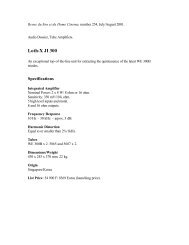
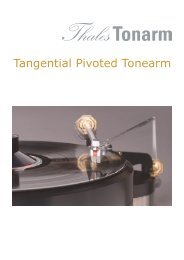
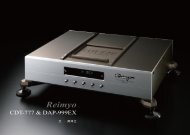

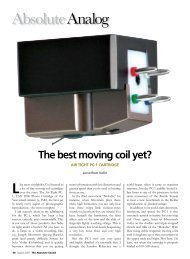
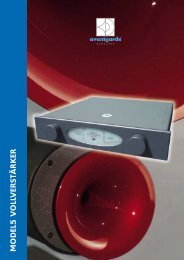
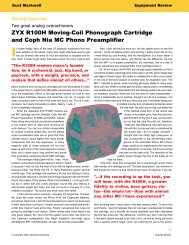
![DAP-999 EX Limited [pdf] - Audio Note Singapore](https://img.yumpu.com/27191044/1/190x253/dap-999-ex-limited-pdf-audio-note-singapore.jpg?quality=85)
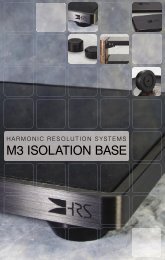
![Harmonix CS-120 Improved-Version [pdf]](https://img.yumpu.com/24411255/1/184x260/harmonix-cs-120-improved-version-pdf.jpg?quality=85)
